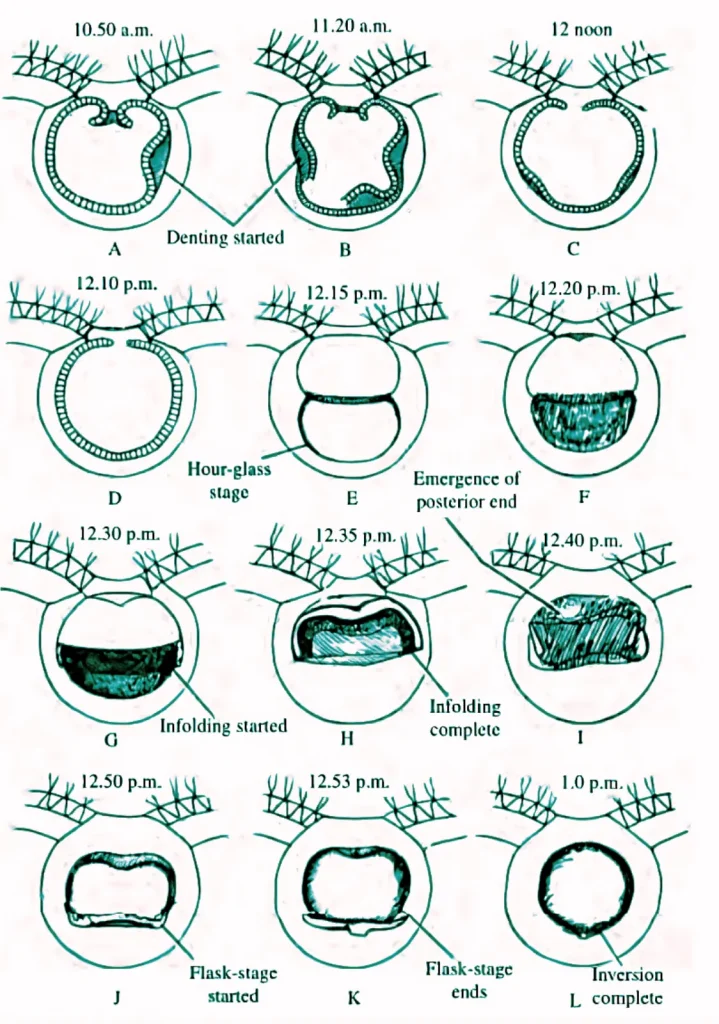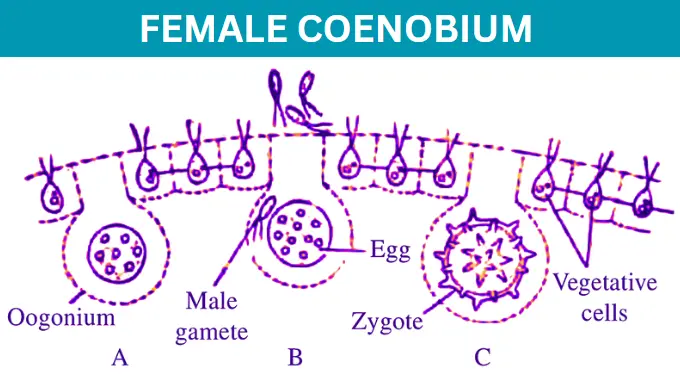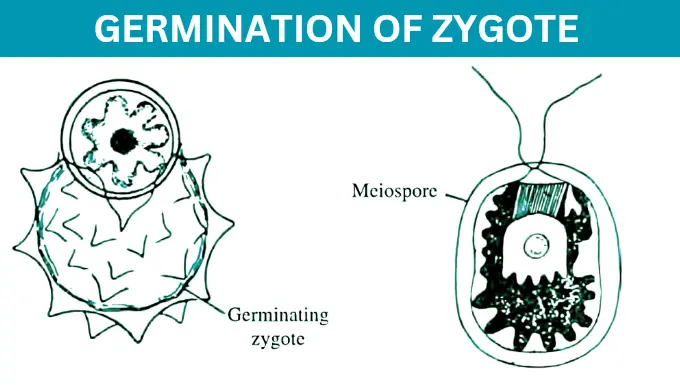Algae can be found in various settings, including soil, freshwater, and the ocean. Due to its colonial character, Volvox is a genus of green algae that is distinct and beautiful. The properties, life cycle, ecological relevance, and future applications of Volvox will all be covered in this article.
Occurrence of Volvox
Volvox, a freshwater alga of pools and ponds, occurs commonly in the rainy season in the form of -small balls of the Size of a pin-head (about 0.5 mm diameter). It is commonly found in the spring when water temperatures begin to rise. The conditions are ideal for volvox to grow and multiply during this time.
Structure of Volvox
Vegetative Structure
The colony formed by Volvox is known as coenobium. The colony is spherical and has between 500 and 50,000 cells. The colony’s interior comprises mucilage, which serves as structural support. The collective motion of the flagella moves the colony forward.
The end facing forward is the colony’s anterior end, while the end facing backward is its posterior end. Every cell in a colony has the same shape and structure. The cells are closely packed and arranged in a polygonal pattern in the colony.
The cell walls of mature cells are thick and mucilaginous, with a thin middle lamella. The pear-shaped cells are embedded within the Daughter periphery of a gelatinous colony matrix. Cytoplasmic filaments connect the colony’s cells, and their pointed ends face outward.
Cell Structure
In most species of Volvox, each cell has a structure similar to Chlamydomonas. Two flagella project beyond the surface of the coenobium, allowing it to move. Two to six contractile vacuoles and a cup-shaped chloroplast with one or more pyrenoids, an eyespot, and a centrally-located nucleus in each cell are also present.
The nucleus is located in the center of the cell and is connected to the flagella by the neuromotor. Cells at the anterior surface of the colony have well-developed eyespots. Thus, a coenobium of Volvox may be a group of Chlamydomonas cells. Each cell is independent and carries out its nutrition, respiration, and excretion.
Reproduction of Volvox
Volvox can reproduce asexually under favorable conditions but also undergo sexual reproduction under unfavorable conditions. In older coenobia, 2-50 or more cells on the posterior side are recognizable due to their large size, prominent nuclei, and dense or granular cytoplasmic contents.
These cells function as asexual or sexual reproductive cells. This suggests that both the anterior and posterior regions of the Volvox colony are involved in reproduction, indicating that the colony exhibits polarity.
Asexual Reproduction
In Volvox, a few cells at the posterior end of the colony undergo enlargement (up to ten times their original size), become more rounded, and withdraw their flagella. Their nuclei and other protoplasmic contents become denser and more prominent.
Because of their large size and these developments, they are pushed back into the colony and can easily be differentiated from the adjacent vegetative cells. These cells are called gonidia or autocolony initials. With the help of successive longitudinal divisions, each gonidium develops into a daughter colony.
Development of Daughter Colony:
When a gonidium develops into a daughter colony in Volvox, it remains enclosed by a gelatinous sac, pushing it into the parent colony’s center. The first division of the gonidium is longitudinal to the colony, while the second is longitudinal but at a right angle to the first one.
This results in four cells undergoing further longitudinal division to form an 8-celled stage called a cruciate plate or plakea. The cells in this stage are arranged so that their concave surface faces toward the outer side.
With one more simultaneous longitudinal division (fourth division) of the cells, a 16-celled stage is produced, and the cells become arranged as a hollow sphere. The divisions continue, and a small aperture called the phialopore is also formed.
The simultaneous longitudinal divisions of the cells of this young colony continue until a specific number of cells, unique to the particular species, is reached.
After completing the division process, all the cells in the daughter colony have their anterior end facing toward the center and their posterior end facing toward the exterior.
This is followed by a process called inversion, where the daughter colony turns inside out so that the concave surface of the cells faces toward the interior and the convex surface faces toward the exterior.
Some species may have as many as 14 or 15 simultaneous longitudinal divisions, resulting in 16,384 or 32,768 or more cells, respectively. However, a few cells may sometimes not divide into the later stages. Despite this variation, Volvox always develops into a coenobium because the number of divisions is definite.

Inversion of Daughter Colony:
The process of inversion begins with a slight constriction at the opposite point of the phialopore. This portion pushes itself towards the anterior half of the young coenobium while the phialopore enlarges and its edges hang backward.
The inside portion of the young coenobium ultimately turns towards the outside through the phialopore, completing the inversion process. At this stage, the phialopore bear’s several lobes gradually fold towards the inner side, closing it down. After inversion, the anterior end of cells faces towards the outer side and the posterior end towards the center.
All cells acquire a cell membrane and two flagella. In some species, daughter colonies are set free within the hollow space of the parent colony. The parent colony’s cells disintegrate, and the daughter colonies mature into new coenobia.
The swelling of the mucilaginous cell walls and enlargement of cells contribute to the young coenobium’s maturation into a well-developed one.

Sexual Reproduction
Volvox is a strictly oogamous organism. Some species, such as V. globator, are monoecious, while others, such as V. aureus, are typically dioecious. Most monoecious species are protandrous, meaning the antheridia (male reproductive structures) develop first.
Specific cells in the colony’s posterior region enlarge, lose their flagella, and develop dense cytoplasmic contents and prominent nuclei. These cells, known as “gonidia-like” cells, are responsible for developing sexual structures, specifically antheridia, and oogonia. As they develop from gonidia-like cells, they are more accurately referred to as androgonidia and gynogonidia.
Development of Antheridium:
The process of sexual reproduction in Volvox begins with the development of an andro-gonidial initial cell, also known as an antheridial initial cell. This cell is large, lacks flagella, and contains a prominent nucleus and dense cytoplasmic contents. It is located on the posterior side of the colony.
The andro-gonidial initial cell undergoes successive longitudinal divisions, similar to the process of asexual reproduction in forming daughter colonies. This results in forming multiple groups of male cells called sperm packets, which are bowl-shaped.
The number of sperm packets varies between 16 to 512, depending on the species. However, generally, their number is between 64 to 128. Similar to the asexual daughter colonies, the sperm packets also undergo an inversion process.

As a result, the tapering end of the packet faces outward, and each male cell develops two flagella, forming a spermatozoid or male gamete. The spermatozoids are unicellular, uninucleate, long, narrow, conical or fusiform, naked, and biflagellate structures.
They also possess a small yellowish-green chloroplast. The spermatozoids remain arranged in a hollow sphere. The ultrastructural development of the spermatozoid in Volvox aureus has been studied in detail by Dearson et al. (1969).
Development of Oogonium:
The development of oogonium in Volvox starts when a vegetative cell on the posterior side of the colony enlarges in size, withdraws its flagella, and takes on a rounded or flask-shaped appearance similar to that of a gonidial cell.
These cells do not divide and become oogonia or female gametangia. The protoplast of the oogonium develops into a single non-flagellated spherical female gamete or egg. This uninucleated egg contains a parietal chloroplast with many pyrenoids and an extensive reserve of food material.

Fertilization:
Fertilization in Volvox is considered internal because the egg remains attached to the colony during the process.
During fertilization in Volvox, the mass of spermatozoids swims as one unit towards the female cells or colony, aided by water and chemotactic stimulation. The spermatozoids reach the oogonium in monoecious species or the female colony in dioecious species.
Some spermatozoids enter the oogonium through its beak, but only one successfully penetrates the egg, likely through a receptive spot. Plasmogamy and karyogamy then occur, resulting in the formation of a diploid zygote.
Zygote and Its Germination:
After fertilization, the resulting diploid zygote quickly forms a thick wall and accumulates haematochrome, causing it to turn red. While some species of Volvox, such as V. aureus, V. monanae, and V. spermatosphaera, have smooth zygote walls, others, like V. globator, have stellate ones. The zygotes are released when the parent colony breaks down and enter a long dormancy in the surrounding water.

After a period of dormancy, the diploid zygote of Volvox germinates when favorable conditions return. Its nucleus undergoes reduction division, forming four haploid nuclei, but typically only one survives.

The zygote’s outer wall, or exospore, breaks, and the inner wall, or endospore, is released as a vesicle. This vesicle encloses the zygotic protoplast, visible as a single biflagellate motile cell or meiospore.
The contents of the meiospore divide and redivide in a process similar to daughter colony formation, resulting in the characteristic number of cells for the species. The process of inversion occurs, and a young multicellular coenobium of Volvox is formed.

Potential Applications of Volvox
Scientists have studied Volvox colonies extensively due to their unique characteristics and potential applications in various fields. Here are some potential applications of Volvox:
- Bioremediation: Volvox can be utilized in bioremediation techniques to eliminate contaminants and poisons in water sources. Algae absorb and degrade these toxins, leaving behind cleaner water.
- Biotechnology: The colonies of Volvox are being investigated for their possible biotechnological applications. Due to their high photosynthetic rate, algae are a prospective source of ethanol and bioenergy.
- Environmental monitoring: Volvox can be used as a bioindicator to monitor the health of aquatic ecosystems. Changes in the algae colony can indicate changes in water quality and pollution levels.
- Education and research: In the field of biology study, Volvox is a well-known model organism. It is frequently utilized in educational settings to educate students about cell biology and the development of multicellular animals.
- Nanotechnology: The spherical shape of Volvox colonies makes them an ideal candidate for use in nanotechnology applications, such as drug delivery and targeted cancer therapy.
FAQs
Is Volvox harmful to humans?
Volvox is not harmful to humans and is generally considered safe to handle.
Can Volvox be found in marine environments?
While Volvox is primarily found in freshwater habitats, some species of Volvox can also be found in marine environments.
What is the size of a typical Volvox colony?
The size of a Volvox colony can vary depending on the species, but it can range from a few hundred micrometers to several millimeters in diameter.
Can Volvox be cultivated in a laboratory setting?
Yes, Volvox can be easily cultured in a laboratory setting and is often used as a model organism in biological research.
What are some potential applications of Volvox?
Volvox has potential applications in medicine, robotics, and renewable energy. Its extracellular matrix has been shown to possess anti-inflammatory and anti-cancer properties, while its flagella can be used as a model for developing artificial micro-swimmers. Its photosynthetic ability can also be harnessed to produce biofuels and bioplastics.
